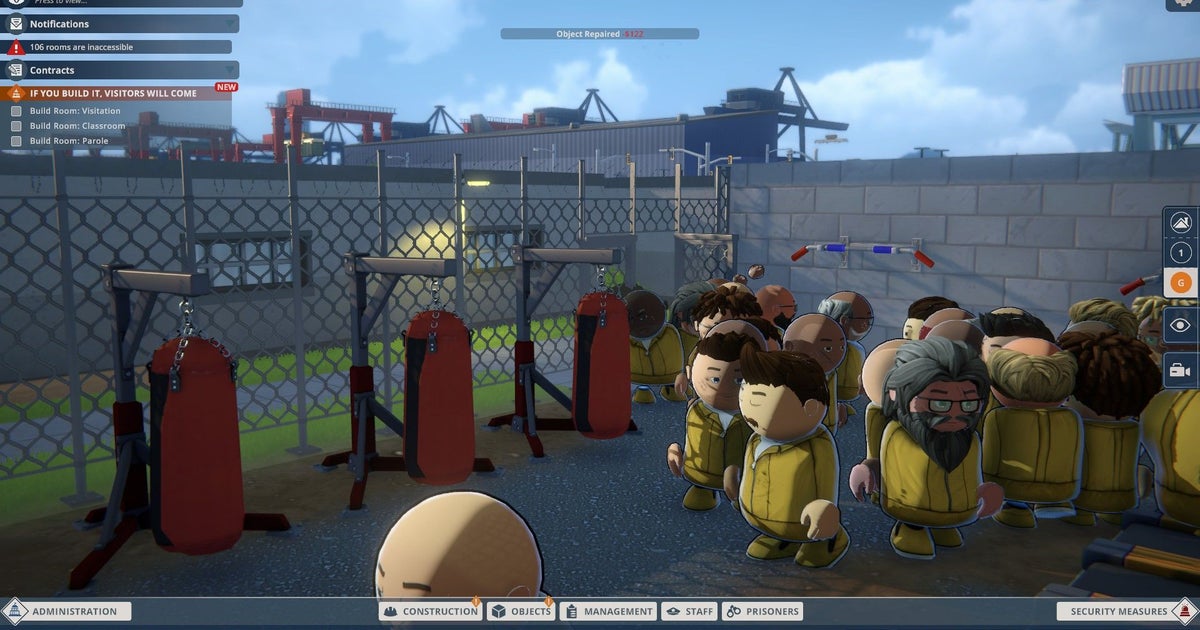There are management games and there are micro-management games. Prison Architect 2 is the latter. I don’t mean this as an annoying thing, like when Harold from corporate starts commenting all over your document at 4.30pm on a Friday. I mean it as a distinction between those games that let you plop down a house, and others that need you to stack the bricks, install the plumbing, fit the lights, and select the wallpaper. The first Prison Architect allowed you to finesse every detail of a secure correctional facility, down to each cell and dog kennel. Unsurprisingly for a sim about prison, it encouraged obsessive control. The 3D-ified sequel isn’t finished yet, but it’s taking a similar approach. Maybe a little too similar.
One of the memorable joys of the first Prison Architect was its ability to generate daft stories. Maybe your best informant gets addicted to drugs and you need to make sure the policy on contraband isn’t too severe because he’ll go into withdrawl. Maybe the on-duty psychologist gets shivved in the kidneys during a therapy session by a maximum security inmate with no respect for the tenets of mindfulness. I only played the sequel for a few hours, so relatively few anecdotes emerged from my hum-drum concrete hellhole. But there were enough hints of trouble to reassure me that similar shennaigans were afoot.

As the eminent “Dr. Videogames”, rehabilitator and administrator of “Bogbutter Penitentiary”, for example, one of my first steps was to sell every tree on the property. The health benefits of natural surroundings be damned. Likewise, when I noticed the entire staff of one of my prisons were hanging out on the bleachers in the prisoner’s yard because there was no adequate staff room, it hinted at a disaster to come, a violent misunderstanding or a dangerous friendship that will surely emerge if I don’t do something about this. I got unsettling feelings about a prisoner called Chung who would not stop pacing in his cell, even as all the other inmates went to sleep.
But that is all I have right now. The seeds of disaster. A pre-shanking foreshadowing. It takes a long time to get things up and running, what with all the wall-building. We are in slow-paced furniture tweaking territory here, even with the generous fast-forwarding buttons that encourage dozens of construction workers to zip around, throwing up fences and heavily barred gates. As with the first game, there seems to be enough depth to ensure events will unfurl in a chaotic mess that your sleek, wet brain will interpret as a drama of Shakespearean ironies. But it is taking me noticeably longer to feel the emergence of those anecdotes. It’s not treacle slow (its predecessor was not without a hunger for your time either) but I do feel some friction where it did not exist before.


There’s a lot of switching back and forth between menus, for example. Prison Architect’s user interface was not perfect (my god) and there was a lot of ground to cover for any player planning things in detail. The sequel feels like a chance to clean that up but so far it only rearranges the disorganised cupboards. Electrical cables and power sources are in a different menu to the lights, for instance, meaning you’ll flip from one to the other quite a lot while doing your electrician routine. The general flow of building a room means you’re always going from construction mode to room-assigning mode to object-placing mode and then back to construction mode to correct some mistake. Few of the objects stand out in clear, distinct ways, so looking into the objects menu feels like opening a drawer of knick-knacks to find the one pen you always use. For a game about control, the menus simply feel hard to read and interpret.
That disorder is not the case everywhere. A career mode teaches you the ins and outs of prison building in a cleaner and more modern way than the previous instalment. Challenge Maps force you to build prisons with particular requirements. A small-scale “pop-up” prison, let’s say, or a prison that can go an entire day without somebody dying (absurd expectation). The world map on which these levels are arranged is also emblematic of the cutesy style change that has seen the papery 2D pawn-world of the previous game transformed into a smooth toy-like diorama of egg-shaped dopes walking around in three dimensions. It’s pleasant enough, yet I can’t help but feel that some of the scrappy character of the original sim has been lost with the shift in artistic style. That and I have doubts even about the practical need for such a change.

Thematically and mechanically, Prison Architect is about control. It is about little people’s lives being directed to a tragicomically draconian degree. But if this franchise is all about being the overbearing loon in charge of every minor detail, does a 3D camera complement that feeling of jealous control? For me, not hugely. If anything, the top-down 2D view of the original allowed you to quickly parse more information. To place and remove items more cleanly, to build and demolish walls more efficiently. The ability to rotate the camera all around to get a proximate peep at your penitentiaries is cool. But it’s also of limited value. It even sometimes gets in the way of clean and functional click ‘n’ drag management.
One way this manifested is that I often ended up rotating the camera directly overhead to emulate as flat a top-down view as possible, in an effort to be more precise with my wall construction and object placement. I was instinctively and unconsciously trying to return to 2D comforts, the behavioural equivalent of being gifted a top-of-the-range gaming PC and immediately installing Age of Empires 2. That might be the result of a dusty mind unwilling to get to grips with the realities of, you know, space. But it might also be the fact that Age of Empires 2 was a banger and Age of Empires 3 was not. Incidentally, did you know that the original Prison Architect had a hidden 3D mode? It was an interesting novelty, a rudimentary test by the developers. But when it comes to running your prison, why would you ever use it?

This is the first big fence Prison Architect 2 must dig itself a tunnel under. The direction it pushes in feels vaguely unnecessary. A new camera-swirling perspective barely feels like enough of a step to justify starting over again as a fan of the first prison sim. Especially if you’re an obsessive who has smuggled all the existing DLC into your 2D prisons, in which case doing all that again (undoubtedly with Paradox’s classic hunger for DLC drip-feeding) may seem a lot to ask.
On top of this, the preview version I played was very crashy. Normally, this wouldn’t be a huge concern. When it comes to getting early builds, journos expect a bit of roughness. However, the game has already seen two delays stemming from the need to fix stability issues and other “technical challenges”. Following that news, the developers who worked on it, Double Eleven, have parted ways with the publisher and owners of the franchise, Paradox Interactive.

So now a whole other studio, Kokku, has been handed the game to finish in time for its September release. Kokku have been helping on the project since last autumn, but still, the departure of the entire initial team mere months before release doesn’t inspire confidence. It takes long enough just to find the right button to press on a new microwave, never mind where all the bugs are hiding in the tangled code of a video game your workmate has handed to you, at the proverbial 4.30pm on a Friday.
It wouldn’t yet be fair to judge the game too squintingly. It does include all the elements of a sim that will provide silly stories about escaping prisoners crawling through sewer pipes only to climb out of the warden’s toilet. But I fear simply doing this in 3D won’t be enough to surpass one of the best management games on PC. The developers left holding the blueprints have more barbed wire to cut if they want to escape the shadow of the original.

